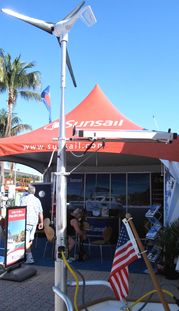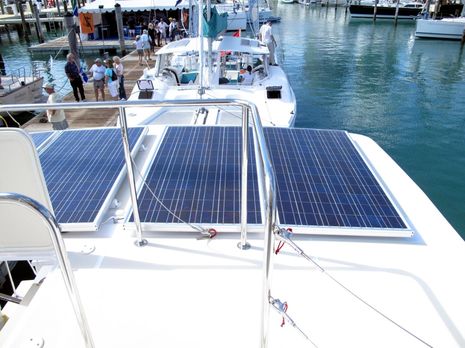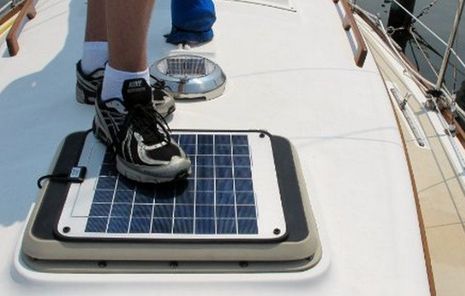The Solar Stik power tower, & Ganz marine panels
 I was glad to see the Solar Stik back at the Miami Show. I’d been impressed with the engineering — especially that sweet taper — when it was first introduced years ago, and it was nice to learn how many markets the company has found since. I also got a demo (that’s why the photo shows one of the two panels is completely removed, which took seconds), and thus I’m pretty sure that it would be easy to do the turning and tilting required to get the maximum power out the normal panel pair. I may romanticize the notion of putting one’s rum swizzel down every few hours to tune the solar array while laying in some tropical anchorage, but I don’t think there’s any denying that solar amps are directly related to angle of sunlight (15 degrees in any direction is the key fall-off point, according to the Stik guy). But would a power tower like this make sense on an amp-thirsty cruiser like Gizmo?
I was glad to see the Solar Stik back at the Miami Show. I’d been impressed with the engineering — especially that sweet taper — when it was first introduced years ago, and it was nice to learn how many markets the company has found since. I also got a demo (that’s why the photo shows one of the two panels is completely removed, which took seconds), and thus I’m pretty sure that it would be easy to do the turning and tilting required to get the maximum power out the normal panel pair. I may romanticize the notion of putting one’s rum swizzel down every few hours to tune the solar array while laying in some tropical anchorage, but I don’t think there’s any denying that solar amps are directly related to angle of sunlight (15 degrees in any direction is the key fall-off point, according to the Stik guy). But would a power tower like this make sense on an amp-thirsty cruiser like Gizmo?
Well, the fact is that Gizmo’s at-mooring power needs are quite like a cruising sailboat’s — especially as I make the switch to LED lighting — and though she has a generator, I hate running it. And perhaps due to a perverse sense of humor I like to imagine a Solar Stik powder painted white and mounted way aft on her boat deck (start your mental picture with the Forum header shot, minus the tender boom). Wouldn’t Gizmo then be yawl rigged with gadgetry? And while that probably doesn’t make much sense as there’s plenty of room back there for a more standard panel install, I’m still thinking of a tilt mechanism as the sun up here is so low and the boat’s position at her (powerless) home float is stern South.
Of course the KISS approach is to simply bolt panels to a horizontal cabin top, as seen here aboard the latest Maine Cat P-47, which is a real beaut with an extended top shading its cockpit and a hard top over its flying bridge. But then again, the experienced owners — who say the ride of the boat-I-almost-bought is “just amazing” — like tropical cruising while my dermatologist and I agree that I’ve already had my share. (Unfortunately there aren’t any photos of this latest build in the MC site, but I was pleased to find my MBHH write up; please support Maine boatbuilders!)…
for not much more than I paid for 7 watt Sunslick and controller. Does anyone know if these Ganz panels perform as claimed?















If your rum swizzle makes you get up _that_ often, you could try adjusting some hinged, polished aluminum reflectors next to your horizontal PV panels. Fold them down over the panel when hail threatens…/)
Hi Ben,
Once more the power conundrum…solar and/or wind, and the constant pull of the fossil fuel option. Yes we hate to run generators. Noisy, smelly, ungreen, expensive, but, for some boats, the only option. Sport-fish have practicaly no natural ventilation, so they rely on diesel power for electricity and ventilation. We all admire catamarans with their impressive solar arrays and multiple wind generators, but they have the advantage of square footage on deck. The salty, long distance mono-hulls sport stern arches loaded with solar panels, wind generators, davits, antenna farms…weight and windage. Consider the performance cruiser
http://www.flickr.com/photos/34531591@N07/5521061874/in/set-72157616714487505/
This kind of boat is designed for low windage. Wind and solar aren’t suitable for all boats. A light-weight, single cylinder diesel engine driving a high-output alternator is an efficient alternative to sailboat power needs. On my boat Cayenne, a J42, we can put about 40 amp/hrs an hour into our battery bank, day or night, at anchor or underway with a 140 amp alternator driven by a Kubota EA300. At anchor we run two hours a day, at 12 hour intervals. While passage-making under sail we run the genset 3 times during the night and 1 hour during daylight for an hour at a time, consuming 1 1/2 pints of diesel per hour. I would still love to think that solar and wind could supply our needs, but too often I see sailboats with sophisticated solar and wind systems running their engines to charge their batteries. Different boats require different energy solutions.
http://www.flickr.com/photos/34531591@N07/3444757770/in/set-72157616714487505/
I have seen the Ganz panels all over the net but have as of yet to see one review or user photo. They seem to be a great option if they perform. Eager to hear from anyone with Ganz experience.
Good points, Reed, and readers please note that if you page thru Reed’s flickr site, you’ll find more pictures of his home built DC generator system (which impressed me when I got to see it here in Camden last summer). Note also John Harries recent Attainable Adventures discussion about the dangers of too much stuff on deck: http://goo.gl/7nJ8R
Reed, I was wondering it you have detailed the build of the generator anywhere.
For example do you control the speed, is that a throttle actuator or just a stop solonoid
Dave
Ben: You are correct that when you look at dollars per generating capacity, a fixed panel will win every time. Only if space is very limited, would a tracking panel be a viable option.
As for wind turbines, the amount of power that can be expected depends on where one cruises. http://www.windpoweringamerica.gov/windmaps/offshore.asp shows a wind map of near offshore United States. This map was produced to assist in choosing sites for offshore wind farms, but the basic principal is applicable. SE US is a low wind area, and Florida is so low that it isn’t even rated. Maine and NH are much better. Similar maps are available for other parts of the world.
The other principal that you are on to is that it is always better and cheaper to save a watt than to make a watt. Therefore we should spend our money first on LED lights and other energy saving devices, and second on solar/wind power generators.
On my sailboat I have 400 Watts of solar on two panels and a MPPT controller (outback power). It takes care of most of my power needs while cruising. About once every two weeks I have to run my generator for an hour or two in the morning so I can top up the batteries.
I chose to fix mount the panels after I visited another boat with solar. The boat moved at anchor and the owner was constantly running to change the panels. I just could not see myself performing this aerobic activity.
Remember that the solar panels can only charge efficiently from 50% to 80% of the battery capacity. This means the larger the battery bank the more efficient your power retention will be.
Also, if your panels are running when your largest loads are drawing you will be more efficient (Peukert factor). This means you run your refrigeration during the day.
My 4 80 watt panels are fixed flat to the pilothouse roof on my catamaran.(sail)
I briefly considered moveable options but quickly dropped the idea,waaaay too much more work and complications.
Let’s remember that most any sort of tracking scheme, like the SolarStik, let’s you leave the panels horizontal if you want. I may have an unusual situation where Gizmo sits almost perfectly stern South much of the time, though I’m still on board a lot and using juice, but anyone hanging in northern latitudes ought to think some about tilt and turn. Here at 44 North, the sun’s zenith at Equinox is only 46 degrees, and still only 69 at Solstice. By the way, NOAA’s got a neat web app for this:
http://www.esrl.noaa.gov/gmd/grad/solcalc/
Remember when getting thin panels they require more cells to overcome the voltage drop they suffer when they become to hot as they have no ventilation.
Hello Ben,
Thank you for the nice article you posted. Our panels are fairly new to the market and have had great success to far. Beside the fact that they are highly efficient, customers love that there is no glass to worry about and that they are very light in weight. Our largest panel (55 watts) is only 7 lbs. For more than 30 years, Ganz has been a leader in the manufacture of intelligent video surveillance solutions. The developement of the GANZ Eco-Energy line of solar panels takes this experience and philosphy to the next level.
Sincerely.
Janice Martin
Sailnet had an epic 130 page thread about the SolarStik performance claims and the pros and cons. The point I would like to make is for the price of the SolarStik you can add a large number of additional panels to your deck where they will not cause wind drag and you avoid the weight of mounting brackets. Aurinco.com features their brand of walk-on panels which are non-skid and have concealed wiring. They are slightly flexible and available in long narrow dimensions that will fit many deck spaces. Add enough deck panels and you will have your desired power in spite of low angles or shade, with no brackets or adjustments needed.
Sailnet SolarStik: http://goo.gl/U96f7
Aurinco panels: http://goo.gl/uPfbP
I was talking about solar panels to Bill Strassberg (Visions of Johanna) yesterday, and, whereas he’s concerned about asthetics, I mentioned these super low profile and slightly bendable Ganz panels. I also said that they probably didn’t provide the same wattage per square inch, but I hadn’t actually done the math.
Well, Bill did, and he tells me that the Ganz 55 watt models about to come out are at 12.9 sq in per watt while the Kyoceras I’m considering are 11.4. Which is not too bad a difference considering their profile, weight, and durability. Kyocera discussion here: http://goo.gl/6QOS1
Ben – Be very careful in comparing the flexible solar cells to the hard solar cells. One of the main problem arises in that the hotter the solar cell becomes the less effective it is. You need an air gap or some other cooling behind the solar cell to cool it. If possible the air gap should provide a chimney effect. Also, the hard solar panels typically have metal (aluminum) backing that helps to dissipate the heat.
I have two Kyocera 210 watt solar cells and in real terms I get ~ 200 Watts of power for 5 hours a day out of them. The biggest difference I have found in solar is the MPPT controllers (I have an outback power 60 system). I am not saying I don’t love my solar system,I think it is great. I just wanted to help others manage their expectations.